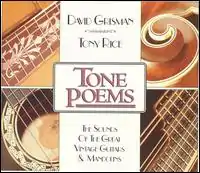| Tone Poems | ||||
|---|---|---|---|---|
 | ||||
| Studio album by | ||||
| Released | 1994 | |||
| Recorded | February 2, 1993 – January 15, 1994 | |||
| Studio | Dawg Studios | |||
| Genre | Folk, bluegrass | |||
| Length | 48:16 | |||
| Label | Acoustic Disc | |||
| Producer | David Grisman | |||
| Tony Rice chronology | ||||
| ||||
| David Grisman chronology | ||||
| ||||
| Review scores | |
|---|---|
| Source | Rating |
| Allmusic | |
Tone Poems: The Sounds of the Great Vintage Guitars and Mandolins is an album of duets by mandolinist David Grisman and guitarist Tony Rice using vintage instruments.[1][2]
Track listing
All tracks are written by Dave Grisman except where noted
| No. | Title | Length |
|---|---|---|
| 1. | "Turn of the Century" | 2:55 |
| 2. | "The Prisoner's Waltz" | 4:17 |
| 3. | "Sam-Bino" | 2:38 |
| 4. | "Grandfather's Clock" (traditional) | 3:12 |
| 5. | "Good Old Mountain Dew" (traditional) | 2:19 |
| 6. | "I Am a Pilgrim" (traditional) | 3:33 |
| 7. | "Mill Valley Waltz" | 3:25 |
| 8. | "Vintage Gintage Blues" | 3:15 |
| 9. | "I Don't Want Your Mandolins Mister" (traditional) | 2:17 |
| 10. | "Dawg After Dark" | 4:38 |
| 11. | "Wildwood Flower" (traditional) | 2:47 |
| 12. | "Morning Sun" | 4:12 |
| 13. | "Banks of the Ohio" (traditional) | 2:23 |
| 14. | "Swing '42" (Django Reinhardt/Stephane Grappelli) | 3:03 |
| 15. | "Watson Blues" (Bill Monroe) | 3:30 |
| 16. | "’O sole mio" (traditional) | 2:11 |
| 17. | "Song for Two Pamelas" | 4:22 |
Personnel
- David Grisman – mandolins
- Tony Rice – guitars
Some of the songs were performed on instruments made when the songs were written to allow the listener to experience the tonal properties of the original performances.
- Track 1: Martin 1-21 (1891), Gibson A-4 (1905)
- Track 2: Gibson Style "0" (1923), Gibson "3-Point" F-4 (1909)
- Track 3: Maurer Style 953 (c. 1915), Lyon & Healy Style A (1925)
- Track 4: Stahl Style 473 (1931), Vega Style 202 Lute Mandolin (1919)
- Track 5: Martin OM-18 (1931), Gibson A-2Z "Snakehead"(1924)
- Track 6: Martin D-28 (1935), Gibson Lloyd Loar F-5 (1923)
- Track 7: Martin 000-45 (1937), Gibson A-4 "Snakehead" (1924)
- Track 8: Regal "Le Domino" (1930's), S.S. Stewart "Snow Queen" (1930s)
- Track 9: Martin D-45 (1939), Gibson "Loar" A-5 (1923)
- Track 10: Gibson J-100 (1939), Gibson "Fern" F-5 (1925)
- Track 11: Gibson L-Century (1936), Martin Style 2-30 (1936)
- Track 12: Gibson Advanced Jumbo (1937), Gibson F-12 (1934)
- Track 13: Martin 0-18 (1937), Epiphone strand (1937)
- Track 14: Selmer (1950), Gibson F-10 (1934)
- Track 15: Martin D-18 (1943), Gibson F-4 (1942)
- Track 16: Martin D-28 (1952), Gibson Prototype A-5 (1953)
- Track 17: Santa Cruz Tony Rice Model (1993), Gilchrist Model 5 (1993)[3][4]
References
- 1 2 Dryden, Ken. "Tone Poems". AllMusic. Retrieved 4 May 2018.
- ↑ "Tone Poems". Acoustic Disc. Retrieved 4 May 2018.
- ↑ Grisman, David (1994). Tone Poems (booklet). Tony Rice. San Rafael, California: Acoustic Disc. p. 4–.
- ↑ Grisman, Dave. "Tone Poems Deluxe Edition" (pdf). Acoustic Oasis. Retrieved 4 May 2018.
This article is issued from Wikipedia. The text is licensed under Creative Commons - Attribution - Sharealike. Additional terms may apply for the media files.